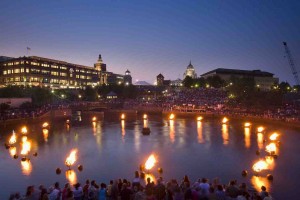 It’s possible we take WaterFire for granted.
It’s possible we take WaterFire for granted.
That in and of itself may seem impossible. Surely — if you’ve spent any summers in Rhode Island since 1994 — you’ve braved the crowds and spent an evening circling the river basin in Waterplace Park, tried to catch a human statue blinking in Memorial Park and stood on the College Street bridge, hypnotized by the bonfires burning in braziers down the Providence River. Annually, WaterFire brings $114 million in additional spending to the community and local businesses. Just this May, Smithsonian ranked WaterFire one of the “Five Can’t Miss Summer Light Festivals” in the world, setting Providence alongside destinations like Sydney, Australia, and France’s Rouen Cathedral of Notre Dame. How could we take something so visibly successful and iconic to Rhode Island’s image for granted?
It’s not that we overlook its importance to us as a state. It’s more that the staff and volunteers at WaterFire have become such efficient mercenaries at setting up the whole spectacle, stealth in their black — slipping up the river like ninjas with boatloads of wood, breaking tents down in the cloak of night — that we almost forget what goes into it.
“We’re 23 years old and one of our challenges is we create this thing that goes away and then need to remind people of (what’s behind it),” says Peter Mello, WaterFire’s Managing Director. “We’re relatively invisible outside of the event itself.”
This year, WaterFire’s taking steps to improve their visibility with a move into the new WaterFire Arts Center.
The Arts Center, located on Valley Street in the former US Rubber factory, gives WaterFire an opportunity to reframe who they are, according to Mello. In addition to providing a space to consolidate WaterFire’s production and office facilities, and giving an official home to volunteers, Mello says the building is intended to eventually host a museum and store front, as well as possibly a cafe. A chunk of square footage will be used for a workshop and storage for the organization’s boats (WaterFire builds their own), tents, audio gear, trucks, five miles of electrical cable and other wares.
The space, purchased by WaterFire in 2012, is also intended to act as a facility-for-rental, diversifying WaterFire’s revenue. Events hosted so far range from fundraising parties for the Sophia Academy (complete with silks and aerials from the building’s rafters) to the site of celebration for Jessica Lange’s lifetime achievement award from Trinity Repertory on May 22. The main floor is elegantly industrial, and still encompasses many of its historic features, including an 80-foot green gantry crane presiding over the floor. The high ceilings were designed to fit locomotives.
“The building will help us sustain ourselves,” says Mello. “Ten years ago, we asked ourselves, ‘How long should WaterFire last?’ and the answer was, people didn’t want it to end. Our goal with this building is to transform from an artistic event and activity to an institution, which a lot of people think we already are.”
How WaterFire intertwines with the community and state’s fabric came into play in the funding of the WaterFire Arts Center. Barbara Sokoloff, president of Barbara Sokoloff Associates, who worked with WaterFire to develop their funding package, explained in a video on the Arts Center’s website the financial “jigsaw puzzle” the organization faced: “We needed a package with a compelling argument,” she says, “of how this would benefit a low income community, how it would provide economic development, and that it would make the Olneyville neighborhood a better place to live and to work.”
Next door to the Arts Center, 300 apartments are under development. Farm Fresh is also eyeing a prospective space on the river’s corridor. All signs point to the economically oft-ignored neighborhood being ready to pop.
For a non-profit, a hot neighborhood isn’t always a net plus.
“We were super successful in getting creative in raising funds,” Mello says. “But these grants can only be used toward construction. We still struggle with funding for employee salaries and benefits, for our utilities. The building makes us appear all set, but we still have challenges making a world-class event.”
In addition to its core employees, WaterFire has 2,000 volunteers. An average of 200 volunteers act as guides, feed fires, sell merchandise, take photographs, help guests make a wish with Luminarias, and set up and break down during a full fire. With the new building and workshop, Barnaby Evans — founder and executive artistic director — sees even more creative expansion on the horizon. He hopes to one day construct a Gaspee replica.
“People assume it’s easy to do and it’s cheap,” says Mello. “It’s actually a huge logistical feat. We magically transform downtown in a 20-hour period.”
View WaterFire’s summer schedule at waterfire.org.


